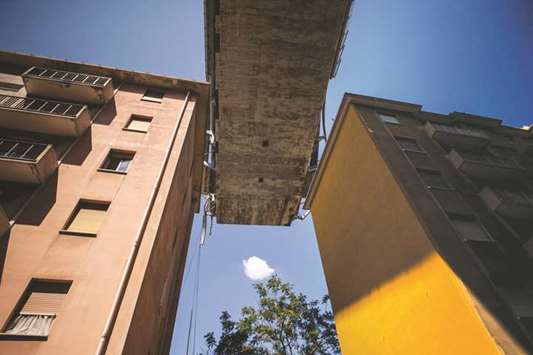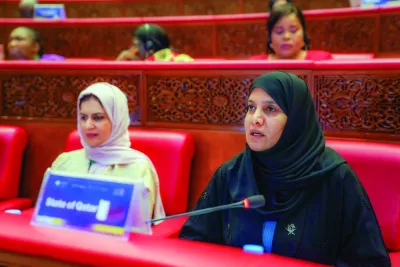The search operation for those missing after a motorway bridge collapsed in the Italian port city of Genoa ended overnight after the last three bodies were found, bringing the official death toll to 43.
A 200m section of the Morandi bridge gave way in busy traffic on Tuesday, plunging vehicles and chunks of concrete and twisted metal to the ground 50m (165’) below.
After three bodies were recovered from a car crushed under slabs of concrete, the Genoa prefecture raised its official death toll.
The three bodies are reported to be those of a couple and their nine-year-old daughter.
The latest names reportedly added to the list of the dead were of a family of three – an Italian-Jamaican couple and their nine-year-old daughter.
“The bodies of the final three missing people were found overnight,” Italy’s fire service said on Twitter yesterday. “The fire service is continuing its inspection of the area in order to rule out the eventual presence of people not reported missing.”
Nine people are still in hospital, four in a critical condition, it said.
While all those listed as missing had now been accounted for, fire brigade official Stefano Zanut told Sky TG24: “Our work continues in order to have the full certainty that nobody has been left under the rubble.”
He said that workers are also making the site secure and helping investigations to establish the cause of the disaster.
The viaduct was part of the A10 motorway linking the port city with the French border to the west and was managed by toll-road operator Autostrade per l’Italia, a unit of infrastructure group Atlantia.
Autostrade pledged €500mn on Saturday to rebuild the bridge and set up funds to immediately assist the families of the victims and those displaced from their homes by the collapse and reconstruction work.
The disaster has caused public outrage and unleashed a fierce debate over the state of Italy’s infrastructure.
The prosecutor investigating the bridge collapse has criticised past management of Italy’s infrastructure.
Francesco Cozzi said the state had “abdicated” its responsibility to ensure road safety by handing motorway management to the private sector, in an interview published yesterday.
“The philosophy of our system today sees a state stripped of its powers, a sort of absent owner,” he told the Corriere Della Sera newspaper.
On Friday, the government launched a procedure to revoke concessions held by Autostrade to operate toll highways.
The government will launch a plan next month aimed at making Italy’s infrastructure safe, Giancarlo Giorgetti, undersecretary in the prime minister’s office, said in a newspaper interview, saying it would include motorways, bridges and viaducts but also public buildings such as schools.
“It will be a maintenance operation with no precedents, with enormous investment in public works,” he told Il Messaggero.
Giorgetti did not specify the cost of the plan but said “deficit, GDP or European rules do not exist”, adding that the European Union “will be benevolent”.
The European Commission limits the budget deficit of EU member states to 3% of GDP.
The Italian government is due to update its economic targets in September before drawing up the 2019 budget and investors are concerned the government’s spending plans might ignore EU fiscal rules and push up the country’s debt, the highest in the eurozone after Greece.
Asked whether the government would halt the procedure against Autostrade if investigators found the group had no responsibility for the bridge collapse, Giorgetti did not answer.
Giovanni Toti, president of the Liguria region where Genoa is located, asked that the government concentrate on drafting an “emergency law” for Genoa “that will allow us to work in a speedy fashion” rather than the battle with Autostrade.
Toti said that the hundreds evacuated from homes near or even under what remains of the bridge would be given new housing “within eight weeks”.
“We are working day and night to find comfortable accommodation for everyone,” he wrote on Twitter yesterday. “Work will begin this week. Within eight weeks maximum there will be a home for everyone. No-one should be left behind.”
Italy bid farewell to the victims, including several children, in Saturday’s solemn funeral that was boycotted by a majority of the families, who resented the presence of politicians and derided the ceremony as “a farce”.
Thousands of mourners packed into a makeshift chapel where the coffins of 19 victims had been lined up.
An imam led prayers for two Muslim victims – a poignant gesture in a Catholic country where the far-right is now in power and which has seen a rise in attacks on foreigners.
The tragedy has shaken the whole country.
Key landmarks like Rome’s Colosseum switched off their lights in a sign of respect, while Italy’s top-flight football teams are holding a minute’s silence ahead of their opening games of the new Serie A season starting this weekend.
The Morandi viaduct dates from the 1960s and has been riddled with structural problems for decades, leading to expensive maintenance and criticism from engineering experts.

This picture taken this week shows apartment buildings in Genoa under the Morandi motorway bridge, days after a section collapsed.


